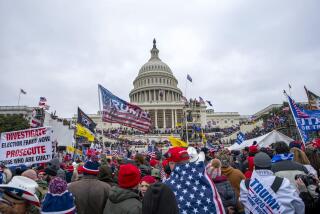Cincinnati Put on Edge as Officer Is Charged in Death
- Share via
CINCINNATI — A white police officer was charged Monday with two misdemeanors for fatally shooting an unarmed black 19-year-old wanted on a dozen traffic violations, an event which touched off three days of riots last month.
The indictments triggered immediate but largely peaceful protests in downtown Cincinnati, which was braced for trouble. Critics attacked the charges, which could send Officer Stephen Roach to jail for a maximum of nine months, as too lax.
Roach killed Timothy Thomas during a predawn foot chase. A racially diverse Hamilton County grand jury handed down the indictment exactly one month after the shooting.
Roach is charged with negligent homicide and obstruction of official business for misleading investigators. He has been assigned to desk duty pending the outcome of his trial.
“I can’t be sure it’s enough to satisfy people that justice has been done, but it’s enough to satisfy them that [Thomas’ death] wasn’t just brushed off as others have been in the past,” Vice Mayor Minette Cooper said.
As rain began to fall and night descended Monday, protesters marched downtown. There were scattered reports of broken windows. Fears of trouble prompted some downtown merchants to board up their stores, and police were put on 12-hour shifts. Religious leaders planned to keep churches open overnight in tense neighborhoods.
As the night wore on, the Cincinnati police scanner crackled with scattered reports of disturbances, from a group of “disorderly” teens harassing a pedestrian to five men throwing rocks.
The Justice Department aimed to defuse tensions by announcing the launch of a civil rights investigation into the Cincinnati Police Department’s tactics, including its use of force. “Our focus will be on assisting the city to solve its problems and rebuild trust among the citizens of Cincinnati,” Atty. Gen. John Ashcroft said Monday.
About 150 people marched to police headquarters in the city’s Over-the-Rhine neighborhood, where officers in riot gear and on horseback watched from a distance. The group dispersed after an hour.
A thunderstorm moved through the area as the indictments were announced, keeping residents off the streets.
“I do feel the rain is the answer to my prayer because I do not believe in violence,” said Jackie Amos, 53, who kept dry inside a church.
Thomas was the 15th black suspect killed by Cincinnati police since 1995. Some of the victims were armed and confrontational. Others, like Thomas, did not have weapons, though the officers who shot them insisted they fired in self-defense.
When he was killed in an alley on April 7, Thomas became an instant symbol for many African Americans of the racism, brutality and injustice that they believe Cincinnati doles out to them daily.
Though the riots subsided after a few days, the anger Thomas’ death provoked still bubbles hot, and city leaders urgently appealed for calm after the grand jury decision was announced. Thomas’ mother, Angela Leisure, also called for peace, though she complained that the charges against Roach were a mere “slap on the wrist.”
Her lawyer was not so conciliatory. “They tell you to be calm, don’t riot, go through the justice system, but when that justice system fails you, what options do you have?” attorney Kenneth Lawson asked, his voice sounding more exhausted than angry. Negligent homicide, he argued, was a charge appropriate for a speeding driver who caused a fatal car wreck, not for the deliberate shooting of a suspect wanted for minor traffic violations.
As the federal investigation revs up, the city has taken steps to calm post-riot racial tension--some symbolic, some more substantive. Mayor Charles Luken has formed a race relations commission, and the city has joined with local business leaders to pump $2.2 million into a summer-job program that will serve as many as 3,000 teenagers.
A racial profiling law took effect Monday, requiring police officers to record the race, sex and age of every person in every car they pull over. Its backers hope the law will reduce complaints by African American men who say they are stopped simply because of their skin color.
And the city has entered into mediation to try to settle a lawsuit accusing the police of using excessive force against blacks for decades.
The violence that convulsed the city after Thomas’ death damaged scores of downtown businesses and injured dozens of people. More than 800 were arrested over three nights of riots. A dawn-to-dusk curfew imposed April 12 quieted the city.
Recognizing that the case was volatile, Hamilton County Prosecutor Michael Allen said he presented every scrap of evidence to the grand jury, going into much more detail than he normally would.
“We would be ignoring reality to treat this case like any other case,” Allen said. The nine jurors heard 20 witnesses, viewed photos of the alley where Thomas was shot, examined video and audiotapes and “deliberated long and hard,” he added.
But Lawson, who has made a career of fighting police brutality, said the charges against Roach were a sign that, for all the upbeat talk about change, Cincinnati has not yet addressed the root causes of last month’s riots.
“These cops have to know that if they continue to do this racial profiling, this shooting of innocent people, this handcuffing and harassing of African Americans, they’re going to be held accountable,” Lawson said. “Until that happens, nothing’s going to change.”
*
Slater reported from Cincinnati and Simon from St. Louis. Associated Press, Times staff writer Eric Lichtblau in Washington and Times researcher John Beckham also contributed.
More to Read
Sign up for Essential California
The most important California stories and recommendations in your inbox every morning.
You may occasionally receive promotional content from the Los Angeles Times.













